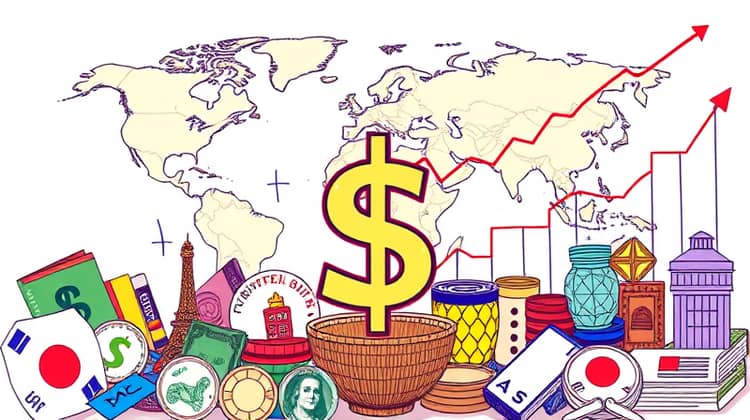In the ever-evolving landscape of global finance, foreign investment plays a critical role in shaping economies. Investors and companies navigate a complex milieu of factors that influence their decision-making processes, with currency strength being a pivotal element.
The strong dollar phenomenon, in particular, significantly affects how foreign investors approach opportunities in the United States and beyond. This article delves into the intricate relationship between foreign investment and the implications of a strong dollar.
As the value of the U.S. dollar rises against other currencies, it can have both positive and negative effects on foreign investment.
Understanding these dynamics is crucial for investors looking to maximize their returns while mitigating risks.
This article examines how a robust dollar influences foreign investment flows, highlights opportunities and challenges for U.S. companies, and offers strategies for investors to navigate this complex environment.
Understanding Foreign Investment

Foreign investment refers to the deployment of capital across national borders, typically to seek better returns or to capitalize on specific economic advantages.
Investors may invest directly by establishing operations in a foreign country or indirectly through financial instruments such as stocks and bonds.
The volatility of currency rates, economic stability, and regulatory environments are key factors that influence these investment decisions.
The movement of foreign capital can greatly impact the domestic economy, driving growth and innovation while sometimes leading to challenges for local industries.
Investors' behaviors are typically conditioned by the strength of their home currency, which affects their purchasing power and investment strategies.
Understanding the motivations behind foreign investment, particularly in the context of a strong dollar, is crucial to navigating current global market trends.
- Foreign investment can take the form of direct or portfolio investment.
- Factors influencing foreign investment include currency exchange rates, economic conditions, and regional stability.
- The strength of the dollar can make U.S. assets cheaper or more expensive for foreign investors.
The Strong Dollar Phenomenon

A strong dollar, characterized by its high value against other currencies, can be both a boon and a bane for investors.
When the dollar's value is high, imports become cheaper for American consumers while U.S. exports may face stiff competition abroad due to increased prices in foreign markets.
This dual effect can shift the balance of trade and influence foreign investment strategies as well.
For investors looking to invest in U.S. assets, a strong dollar can present an enticing proposition.
However, the global dynamics of currency fluctuation complicate the decision-making process, as investments are subject to factors beyond pure economics such as geopolitical events and shifts in monetary policy.
How a Strong Dollar Affects Foreign Investment

The impact of a strong dollar on foreign investment is multifaceted and manifests in various ways. One of the most significant effects is the increased attractiveness of the U.S. market.
When the dollar is strong, foreign investors find U.S. assets more appealing given that they can leverage their own currency for acquisitions, potentially yielding better returns on investments.
Competing economies may struggle to match the inherent value that U.S. investments provide when priced in weaker currencies.
Conversely, as U.S. companies expand internationally, they often face challenges brought on by a strong dollar.
Companies earning revenues in weaker currencies may see their profits diminished when converted back into dollars.
Furthermore, foreign competitors with weaker currencies may price U.S. products out of their markets, leading to potential declines in sales and market share.
Foreign exchange risks also rise significantly for investors. As the dollar strengthens, it becomes increasingly important for investors to consider the volatility in currency values that may impact the profitability of their foreign investments.
A sudden shift in currency exchange rates can lead to substantial losses, underscoring the inherent risks involved in cross-border investments.
1. Increased Investment in the U.S.
With a strong dollar, foreign investors are often incentivized to increase their investments in the U.S. market due to the perceived stability and potential for returns.
- Foreign investors view U.S. equities as safer investments during global uncertainty.
- Real estate in the U.S. becomes appealing as weaker currencies can leverage buying power.
- Technology and innovation sectors attract significant foreign capital due to their robust growth prospects.
2. Challenges for U.S. Companies Abroad
U.S. companies trying to penetrate foreign markets may find the strong dollar a hindrance as they compete against local firms.
- Stronger dollar raises the price of U.S. exports, making them less competitive abroad.
- Foreign revenue converted back to dollars results in diminished returns, affecting profitability.
- Local competitors may have better pricing and profit margins due to currency advantages.
3. Currency Risks for Investors
Investing in foreign assets during a period of a strong dollar involves significant currency risk.
- Fluctuations in currency values can dramatically impact investment returns.
- Hedging strategies may be necessary to protect against adverse currency movements.
- Investors must remain vigilant about international currency trends and adapt their strategies accordingly.
4. Impact on Emerging Markets
Emerging markets often feel the effects of a strong dollar more acutely than developed markets.
The Role of Macroeconomic Factors

Macroeconomic indicators such as interest rates, inflation, and employment rates can also influence foreign investment patterns.
A strong dollar may indicate a healthy U.S. economy, attracting more foreign capital in search of stable returns.
In contrast, global economic instability or negative economic signals can deter foreign investment even in a strong dollar environment.
Investors weigh the health of the domestic and global economy in their decision-making processes.
Strategies for Investors

To navigate the challenges posed by a strong dollar, investors must adopt dynamic investment strategies tailored to current market conditions.
Diversifying investments across currencies and geographical regions can mitigate risks associated with currency volatility.
Incorporating hedging instruments, such as options and futures contracts, can further protect against adverse currency movements and enhance portfolio stability.
- Consider diversifying into markets with currencies expected to strengthen against the dollar.
- Invest in U.S. assets during dollar strength, focusing on sectors that benefit from foreign interest.
- Utilize currency hedges to protect investment against exchange rate fluctuations.
Conclusion

The interplay between a strong dollar and foreign investment presents both opportunities and challenges for investors. Understanding these dynamics is essential for making informed investment decisions in a globalized economy.
As the dollar continues to fluctuate in strength, investors must remain adaptable and aware of the multifaceted impacts it has on their portfolios.
Ultimately, cultivating a strategic approach to investment in the context of currency value will enable investors to navigate the complexities of the global market more effectively.










